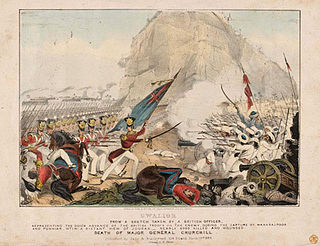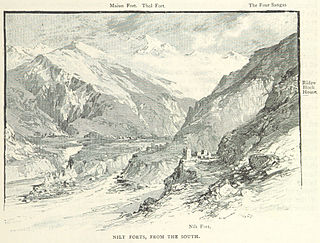 W
WThe Second Anglo-Afghan War was a military conflict fought between the British Raj and the Emirate of Afghanistan from 1878 to 1880, when the latter was ruled by Sher Ali Khan of the Barakzai dynasty, the son of former Emir Dost Mohammad Khan. The war was part of the Great Game between the British and Russian empires.
 W
WThe Third Anglo-Afghan War, also known as the Third Afghan War, the British-Afghan War of 1919 and in Afghanistan as the War of Independence, began on 6 May 1919 when the Emirate of Afghanistan invaded British India and ended with an armistice on 8 August 1919. The war resulted in the Afghans winning back control of foreign affairs from Britain, and the British recognising Afghanistan as an independent nation. According to British author Michael Barthorp, it was also a strategic victory for the British because the Durand Line was reaffirmed as the border between Afghanistan and the British Raj, and the Afghans agreed not to foment trouble on the British side. However, Afghans who were on the British side of the border did cause concerns due to revolts.
 W
WThe Battle of Wadgaon was a battle fought between the Maratha Empire and the British East India Company near Vadgaon Maval village in Maharashtra and was part of the First Anglo-Maratha War.
 W
WThe British Expedition to Abyssinia was a rescue mission and punitive expedition carried out in 1868 by the armed forces of the British Empire against the Ethiopian Empire. Emperor Tewodros II of Ethiopia, then often referred to by the anglicized name Theodore, imprisoned several missionaries and two representatives of the British government in an attempt to force the British government to comply with his requests for military assistance. The punitive expedition launched by the British in response required the transportation of a sizable military force hundreds of miles across mountainous terrain lacking any road system. The formidable obstacles to the action were overcome by the commander of the expedition, General Sir Robert Napier, who was victorious in every battle against the troops of Tewodros, captured the Ethiopian capital, and rescued all the hostages. The expedition was widely hailed on its return for achieving all its objectives.
 W
WThe Chitral Expedition was a military expedition in 1895 sent by the British authorities to relieve the fort at Chitral, which was under siege after a local coup following the death of the old ruler. An intervening British force of about 400 men was besieged in the fort until it was relieved by two expeditions, a small one from Gilgit and a larger one from Peshawar.
 W
WThe First Anglo-Afghan War, also known by the British as the Disaster in Afghanistan) was fought between the British Empire and the Emirate of Afghanistan from 1839 to 1842. Initially, the British successfully intervened in a succession dispute between emir Dost Mohammad (Barakzai) and former emir Shah Shujah (Durrani), whom they installed upon capturing Kabul in August 1839. The main British Indian force occupying Kabul along with their camp followers, having endured harsh winters as well, was almost completely annihilated during its 1842 retreat from Kabul. The British then sent an Army of Retribution to Kabul to avenge the destruction of their previous forces. After recovering prisoners, they withdrew from Afghanistan by the end of the year. Dost Mohammed returned from exile in India to resume his rule.
 W
WThe Gwalior campaign was fought between the British and Maratha forces in Gwalior in India, December 1843.
 W
WThe Hunza–Nagar Campaign was fought in 1891 by troops of the British Raj against the princely states of Hunza and Nagar in the Gilgit Agency. It is also known in Pakistan as the "Anglo-Brusho War".
 W
WThe invasion of Java in 1811 was a successful British amphibious operation against the Dutch East Indian island of Java that took place between August and September 1811 during the Napoleonic Wars. Originally established as a colony of the Dutch Republic, Java remained in Dutch hands throughout the French Revolutionary and Napoleonic Wars, during which time the French invaded the Republic and established the Batavian Republic in 1795, and the Kingdom of Holland in 1806. The Kingdom of Holland was annexed to the First French Empire in 1810, and Java became a titular French colony, though it continued to be administered and defended primarily by Dutch personnel.
 W
WThe Jangir-e-Lae was fought between the British troops and the people of Nagar at the place of Nilt from December 1 to 23, 1891 as part of the Hunza–Nagar Campaign. The Tham (Chief) of that time Azur Khan was leading the combat. The British gained victory and control of Nagar after continuous combat of more than 20 days. Where more than 100 people from Nagar lost their lives and 127 were imprisoned. On the British side, four British Officers and over 50 Dogra levies lost their lives.
 W
WThe Battle of Khushab took place on 7 February 1857 and was the largest single engagement of the Anglo-Persian War. Having taken Borazjan without a fight, the British expeditionary army under Sir James Outram was in the process of withdrawing to Bushehr when it was ambushed by a smaller Persian force under Khanlar Mirza, drawn up in battle order to its rear. The battle ended with a Persian victory and the withdrawal of British troops from Ahvaz, Iran.
 W
WThe Battle of Madras or Fall of Madras took place in September 1746 during the War of the Austrian Succession when a French force attacked and captured the city of Madras from its British garrison.
 W
WThe Battle of Manila was fought during the Seven Years' War, from 24 September 1762 to 6 October 1762, between the Kingdom of Great Britain and the Kingdom of Spain in and around Manila, the capital of the Philippines, a Spanish colony at that time. The British won, leading to a twenty-month occupation of Manila.
 W
WThe Muharram Rebellion was an uprising which took place in early December against the East India Company by the Bengali Muslims led by the Pirzada of Sylhet and his two brothers, Syed Muhammad Hadi and Syed Muhammad Mahdi. The main battle took place in the Mughal-built Sylhet Shahi Eidgah and its surrounding hills.
 W
WThe Battle of Plassey was a decisive victory of the British East India Company over the Nawab of Bengal and his French allies on 23 June 1757, under the leadership of Robert Clive. The battle helped the Company seize control of Bengal. Over the next hundred years, they seized control of most of the Indian subcontinent, Myanmar, and Afghanistan.
 W
WThe Battle of Saragarhi was a last-stand battle fought before the Tirah Campaign between the British Raj and Afghan tribesmen. On 12 September 1897, an estimated 12,000 – 24,000 Orakzai and Afridi tribesmen were seen near Gogra, at Samana Suk, and around Saragarhi, cutting off Fort Gulistan from Fort Lockhart. The Afghans attacked the outpost of Saragarhi where thousands of them swarmed and surrounded the fort, preparing to assault it. Led by Havildar Ishar Singh, the 21 soldiers in the fort—all of whom were Sikhs—chose to fight to the death, in what is considered by some military historians as the greatest last stand in history. The post was recaptured two days later by another British Indian contingent.